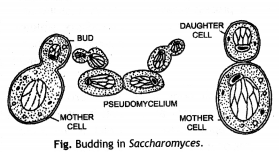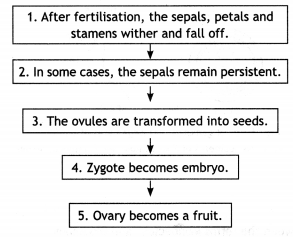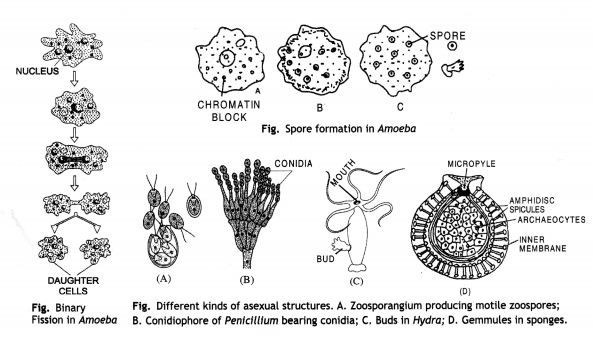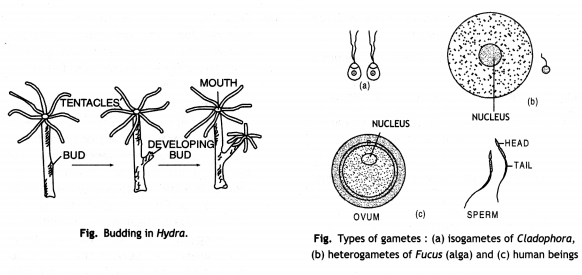Here we are providing Class 12 Biology Important Extra Questions and Answers Chapter 1 Reproduction in Organisms. Important Questions for Class 12 Biology are the best resource for students which helps in Class 12 board exams.
Class 12 Biology Chapter 1 Important Extra Questions Reproduction in Organisms
Reproduction in Organisms Important Extra Questions Very Short Answer Type
Question 1.
What is the life span?
Answer:
The period from birth to natural death of an organism is termed its life span.
Question 2.
Why is reproduction essential for organisms?
Answer:
Reproduction is a process by which an organism produces young ones of its own kind to maintain the continuity of the species. It enables the species to live generation after generation.
Question 3.
What type of modification are ginger, potato, onion and Samarkand?
Answer:
Underground modification of stem.
Question 4.
Name sub-aerial stems which help in multiplication.
Answer:
Pistia, Chrysanthemum Eichhornia, Pineapple.
Question 5.
Name artificial methods of vegetative propagation.
Answer:
- Cutting of stem, root and leaf.
- Grafting
- Layering
- Gootee.
Question 6.
Which type of division is involved in asexual reproduction?
Answer:
Only mitotic division occurs during asexual reproduction.
Question 7.
Male honeybee has 16 chromosomes whereas its female has 32 chromosomes. Give one reason. (CBSE Outside Delhi 2016)
Answer:
Male honey bee develops from haploid unfertilised egg (Ovum), whereas female develops from the diploid fertilized zygote.
Question 8.
The diploid number of chromosomes in an angiospermous plant is 16. What will be the number of chromosomes in its endosperm and antipodal cells? (CBSE Outside Delhi 2019)
Answer:
Number of chromosomes in endosperm = 24 (3N)
Number of chromosomes in antipodal cells = 8(N)
Question 9.
Banana is a true fruit and also a parthenocarpic fruit. Justify. (CBSE Foreign 2008)
Answer:
Banana develops from the ovary (true fruit) and develops without fertilisation (parthenocarpic fruit).
Question 10.
Pick out the ancestral line of angiosperms from the list given below: Conifers, seed ferns, cycads, ferns. (CBSE 2008)
Answer:
Seed ferns.
Question 11.
Why is apple referred to as false fruit? (CBSE 2010)
Answer:
In the case of apple, thalamus contributes to fruit formation, while most of the plant’s fruit develops from the ovary.
Question 12.
Name the type of cell division that takes place in the zygote of an organism exhibiting haplontic life cycle. (CBSE 2011)
Answer:
Meiosis
Question 13.
Mention the unique flowering phenomenon exhibited by Strobilanthus Ludhiana (Neelakuranji). (CBSE 2012)
Answer:
It is a monocarpic flowering plant. It flowers once in 12 years.
Question 14.
Some flowers, selected for artificial hybridisation, do not require emasculation but bagging is essential for them. Give a reason. (CBSE Delhi 2019 C)
Answer:
Bagging is the covering of flower by butter paper on polythene. The emasculated flower buds of the female parent and floral buds or male parent are bagged in order to protect them from contamination with unwanted pollen grains.
Question 15.
Cucurbits and papaya plants bear staminate and pistillate flowers. Mention the categories they are put under separately on the basis of the type of flowers they bear. |HOTSj (CBSE 2012)
Answer:
Cucurbits-Monoecious plants Papaya-Dioecious plants.
Question 16.
Why is banana considered a good example of parthenocarpy? (CBSE 2011)
Answer:
It is propagated vegetatively because there is no seed formation.
Question 17.
Name an alga that reproduces asexually through zoospores. Why are these reproductive units called so? (CBSE Outside Delhi 2013)
Answer:
- Chlamydomonas
- They are called so because they are microscopic motile structures.
Question 18.
Name the phenomenon and one bird where the female gamete directly develops into a new organism. (CBSE Outside Delhi 2013)
Answer:
- Parthenogenesis
- Turkey bird
Question 19.
Name the vegetative propagules in the following: (CBSE 2014)
(a) Agave
Answer:
Bulbils
(b) Bryophyllum.
Answer:
Leaf bud
Question 20.
Mention a characteristic and a function of zoospores in some algae. (CBSE 2010)
Answer:
- Zoospores are microscopic and flagellated motile spores.
- They are reproductive structures.
Reproduction in Organisms Important Extra Questions Short Answer Type
Question 1.
Is there a relationship between the size of an organism and its life span? Give two examples in support of your answer.
Answer:
No, there is no relationship between size and life span of organisms. Large-sized tiger and small-sized dog both live for about 20 years. The very large-sized elephant has a life span of up to 90 years. On the other hand, small-sized tortoise lives for 200 years. Similarly, the mango tree has a much shorter life span as compared to peep at the tree.
Question 2.
Offspring formed due to sexual reproduction have better chances of survival. Why?
Answer:
The offspring formed due to sexual reproduction show variations due to crossing over during gametogenesis, random segregation of gametes or random fertilisation. These useful variations produced in offspring help the organisms to adapt and survive.
Question 3.
How are the progeny formed from asexual reproduction different from those formed by sexual reproduction?
Answer:
The progeny formed from asexual reproduction is genetically similar to the parent, while those formed by sexual reproduction are genetically different from the parents due to new gene combinations formed during crossing over, random segregation and fertilisation.
Question 4.
Mention two inherent characteristics of Amoeba and yeast that enable them to reproduce asexually.
Answer:
- Amoeba and yeast are unicellular organisms.
- Both have a very simple body structure.
- Both reproduce by fission.
Question 5.
Why do we refer to offspring formed by the asexual method of reproduction as clones?
Answer:
Offspring formed by asexual reproduction are called clones because they are morphologically and genetically similar to the parent.
Question 6.
Higher organisms have resorted to sexual reproduction in spite of its complexity. Why?
Answer:
Higher organisms have resorted to sexual reproduction in spite of its complexity because, at the same time, sexual reproduction provides two-fold advantages:
- Here genetic recombination, interaction, etc. take place which causes variations in the offspring thus also form raw materials for evolution.
- The offspring adapt more comfortably and quickly to the changes in the environmental conditions.
Question 7.
What are gemmules and conidia? Name one organism each in which these are formed. (CBSE Sample Paper 2019, 20)
Answer:
Gemmules: These are internal buds. They consist of a small group of archaeocytes, enclosed by a protective coat. They are formed in freshwater sponges e.g. Spongilla.
Conidia: They are formed in Penicillium. They are non-motile spores produced single or in the chain by a constriction at the tip of special hyphal branches called conidiophores.
Question 8.
Give examples of plants which are propagated vegetatively from underground stems and creeping stems.
Answer:
Underground stems. Mint and Chrysanthemum, Banana, Turmeric, Ginger, Aspidium, Adiantum. Creeping stems. Runners (mint, grass), stolons (strawberry) and offset (Eichhornia).
Question 9.
Differentiate between a zoospore and a zygote.
Answer:
Difference between a zoospore and a zygote:
|
Zoospore |
Zygote |
| 1. It is an asexual spore produced by algae and some fungi and Is capable of moving about by means of flagella. | 1. It is a non-mottle cell produced by the certain union of male and female gametes. It Lacks flagella. |
| 2. It Is haploid or diploid in nature. | 2. It is diploid in nature. |
Question 10.
List the pre-fertilisation events.
Answer:
Pre-fertilisation events. These include all the events of sexual reproduction prior to the fusion of gametes. The two main pre-fertilisation events are gametogenesis and gamete transfer.
Question 11.
Why does the zygote in angiosperms start developing into embryo only after some endosperm is formed?
Answer:
Zygote in angiosperms starts developing into embryo only after some endosperm is formed because endosperm is nutritive in function. It provides nutrients to the zygote for further growth and development.
Question 12.
Why is the offspring formed by asexual reproduction referred to as clone?
Answer:
The offspring formed by asexual reproduction is referred to as clone because the offspring is morphologically and genetically similar to the parent.
Question 13.
Mention the site where syngamy occurs in amphibians and reptiles respectively. (CBSE 2010)
Answer:
- In amphibians, syngamy occurs in the external medium, i.e. water.
- In reptiles, syngamy occurs in the body of an organism.
Question 14.
Why do internodal segments of sugarcane fail to propagate vegetatively even when they are in contact with damp soil? (HOTS) (CBSE Sample Paper)
Answer:
Sugarcane plants propagate vegetatively only when nodes are in contact with damp soil. Adventitious roots emerge from nodes and not from internodes because nodes bear buds.
Question 15.
Why do algae and fungi shift to a sexual mode of reproduction just before the onset of adverse conditions? (CBSE Delhi 2014, 2015)
Answer:
The organisms produced through asexual reproduction have low adaptability to the changing environment. Thus algae and fungi shift to a sexual mode of reproduction during the onset of adverse conditions.
Question 16.
A moss plant produces a large number of antherozoids but relatively only a few egg cells. Why? (CBSE 2010)
Answer:
In a moss plant, an antheridium produces many sperms while one archegonium produces only one egg cell. That is why there are a large number of antherozoids and a few egg cells.
Question 17.
Mention the reasons for the difference in ploidy of zygote and primary endosperm nucleus in an angiosperm. (CBSE 2010)
Answer:
A zygote is diploid (2n) as one male gamete fuses with egg or oosphere, while primary endosperm nucleus is triploid as one male gamete fuses with a secondary nucleus which is already diploid.
Question 18.
In haploid organisms that undergo sexual reproduction, name the stage when meiosis occurs. Give reasons for your answer.
Answer:
Haploid organisms form gametes without meiosis. Mate and female gametes fuse to form a diploid zygote. Zygote being diploid undergoes meiosis to form haploid organisms e.g. Ulothrix, Chlamydomonas.
Question 19.
Describe the importance of syngamy and meiosis in the life cycle of an organism. (CBSE Delhi 2016)
Answer:
Syngamy is a fusion of haploid gametes. It restores diploid nature in the zygote. Meiosis occurs during gametogenesis, thus produces haploid gametes. Both are important for maintaining chromosome number (ploidy) in an organism.
Question 20.
Angiosperms bearing unisexual flowers are said to be either monoecious or dioecious. Explain with the help of one example each. (CBSE Delhi 2016)
Answer:
In dioecious plants, male flowers termed a staminate flower, and female flowers, termed as pistillate flowers, are borne on different; plants. Thus plants are either male or female.
Examples: Papaya, date palm, etc.
In monoecious plants, male and female flowers are present on the same plants. Example: Maize, coconut, cucurbits, etc.
Question 21.
Write the significance of meiocytes. (CBSE (Delhi) 2016)
Answer:
Significance of meiocytes. Meiocytes are gamete-producing cells which undergo meiosis. They are diploid. As a result of meiosis, they produce haploid gametes. During fertilisation, a fusion of haploid gametes restores diploid nature of zygote. It undergoes mitosis to form complete new young one.
Question 22.
Why do organisms like algae and fungi shift from asexual mode of reproduction to sexual mode? (CBSE Delhi 2018C)
Answer:
During favourable conditions, organisms opt for asexual reproduction but when the conditions are adverse or unfavourable, organisms undergo sexual reproduction.
Question 23.
What is a juvenile phase in organisms? (CBSE Delhi 2018C)
Answer:
It is the stage of growth and attaining maturity in their life before they can reproduce sexually. It is also called the vegetative phase.
Question 24.
(i) State the difference between meiocyte and gamete with respect to chromosome number.
Answer:
Meiocytes are diploid (2n) and gametes are haploid.
(ii) Why is a whiptail lizard referred to as parthenogenetic? (CBSE 2012)
Answer:
Whiptail lizard eggs develop without fertilisation
Reproduction in Organisms Important Extra Questions Long Answer Type
Question 1.
Define:
(i) juvenile phase,
Answer:
Juvenile phase. The period of growth in the life of organisms before they start reproducing sexually and attain a level of maturity is called juvenile phase. It is followed by the reproductive phase.
(ii) reproductive phase
Answer:
Reproductive phase. The period of active reproductive behaviour, when the organisms show marked morphological and physiological changes is called reproductive phase. It is followed by senescence phase.
(iii) senescence phase.
Answer:
Senescence phase. The period when the reproductive phase ends and concomitant changes occur in the body such as slowing of metabolism is called senescence phase. It is followed by death.
Question 2.
Distinguish between asexual and sexual reproduction. Why is vegetative reproduction also considered as a type of asexual reproduction?
Answer:
1. Differences between asexual reproduction and sexual reproduction.
| Asexual Reproduction | Sexual Reproduction |
| 1. The process involves only one cell or one parent. | 1. This process involves two cells or gametes belonging to either the same or different parents. |
| 2. The whole body of the parent may act as a reproductive unit or it can be a single cell or a bud. | 2. The reproductive unit is called gamete which is unicellular and haploid. |
| 3. The offspring are genetically similar to the parent. | 3. The offspring differ from the parents. |
| 4. Only mitotic division takes place. | 4. Meiosis and mitosis both take place. |
| 5. No formation of sex organs. | 5. Formation of sex organs is essential. |
| 6. No evolutionary significance. | 6. It introduces variation; hence it is of evolutionary significance. |
2. Vegetative reproduction is also considered a type of asexual reproduction because it does not involve meiotic division and there is no formation and fusion of gametes.
Question 3.
How does an encysted Amoeba reproduce on the return of favourable conditions? (CBSE Sample Paper 2019-20)
Answer:
Multiple fission in encysted Amoeba:
- Amoeba withdraws pseudopodia and secretes a cyst wall around itself. This phenomenon is called encystation.
- Amoeba divides by multiple fission.
- It produces a large number of pseudo- conidiospores.
- The cyst wall breakdown.
- The spores are liberated and settle down on suitable substrates and grow as amoebae. This process is also called sporulation.
Question 4.
Discuss the advantages and disadvantages of asexual reproduction.
Answer:
Advantages of asexual reproduction:
- It involves simple mitotic division in single-parent and it may produce a large number of young ones.
- Young ones produced by asexual methods are genetically similar to the parent.
- It helps in the dispersal of offspring to far off places.
Disadvantages of asexual reproduction.
- The young ones thus produced do not possess much capacity to adapt rapidly to the environmental changes taking place in quick succession.
- No genetic recombination occurs; thus no variation occurs.
Question 5.
Discuss the advantages and disadvantages of sexual reproduction.
Answer:
Advantages of sexual reproduction:
- Genetic recombination, interaction, etc. take place which causes variations in the offspring, thus also form raw materials for evolution.
- The offspring adapt more comfortably and quickly to the change in environmental conditions and have better chances of survival.
Disadvantages of sexual reproduction. Usually, two parents of opposite sexes are required (except in hermaphrodite).
Question 6.
List various methods of natural vegetative propagation. Give examples:
Answer:
- Vegetative propagation by stems, e.g.Grasses, Turmeric, Onion, Colocasia, Potato, Gladiolus and Crocus.
- Vegetative propagation by roots, e.g. Murraya sp., Albizzia Lebbac, Dalbergia sissoo, Tuberous roots of sweet potato, Asparagus, Tapioca, Dahlia and Yams (Dioscorea).
- Vegetative propagation from reproductive organs. Flower buds of century plant (Agave sp.) develop into bulbils.
Question 7.
Define external fertilisation. Mention its disadvantages:
Answer:
The fertilisation in which the fusion of gametes occurs outside the body of the female in an external medium, i.e. water, is called external fertilisation.
Examples. Bony fishes, amphibians, etc. Organisms that exhibit external fertilisation show great synchrony between the sexes in order to liberate the gametes at the same time.
Disadvantages of external fertilisation:
- A large number of gametes are produced to ensure fertilisation, thus there is wastage.
- The offspring formed are extremely vulnerable to predators, thus threatening their survival up to adulthood.
Question 8.
Explain the process of budding in yeast. (CBSE 2010)
Answer:
Budding in yeast. It is a common type of vegetative reproduction. In a medium which is abundantly supplied with sugar, yeast cytoplasm forms a bud-like outgrowth. The growth soon enlarges and a part of the nucleus protrudes into the bud and breaks off. The bud then begins to grow and then separates from the mother cell. Often it will itself form a bud before it breaks away, and straight or branched chains are produced.

Thus, as a result, branched or unbranched chains of cells called pseudo my cilium are produced. The cells are loosely held together. Sooner or later they become independent.
Question 9.
Describe the importance of vegetative propagation.
Answer:
Merits of vegetative propagation:
- Plants produced by vegetative propagation are genetically similar and constitute a uniform population called a clone.
- Plants with reduced power of sexual reproduction, long dormant period of seed, poor viability, etc. are multiplied by vegetative methods.
- Some fruit trees like banana and pineapple do not produce viable seeds. So these are propagated by only vegetative methods.
- It is a more rapid and easier method of propagation.
- Good characters are preserved by vegetative propagation.
- Some plants such as doob grass (Cynodon dactylon) which produce only a small quantity of seed are mostly propagated by vegetative propagation.
- Grafting helps in getting an economically important plant having useful characteristics of two different individuals in a short time.
Question 10.
Describe the post-fertilisation changes in a flower.
Answer:
Post-fertilisation changes in a flower.

Question 11.
Write a note on sexuality in plants.
Or
Coconut palm is monoecious while date palm is dioecious. Why are they called so?
Answer:
Sexuality in organisms: Sexual reproduction in organisms generally involves the coming together of gametes from two different individuals. But this is not always true.
Sexuality in Plants: Plants may have both male and female reproductive structures in the same plant (bisexual) or on different plants (unisexual). In several fungi and plants, terms such as homothallic and monoecious are used to denote the bisexual condition, and heterothallic and dioecious are used to describe the unisexual condition.
In flowering plants, the unisexual male flower is staminate, i.e. bearing stamens, while the female is pistillate or bearing pistils. In some flowering plants, both male and female flowers may be present on the same individual (monoecious) or on separate individuals (dioecious). Some examples of monoecious plants are cucurbits and coconuts and dioecious plants are papaya and date palm.
Very Important Figures:

